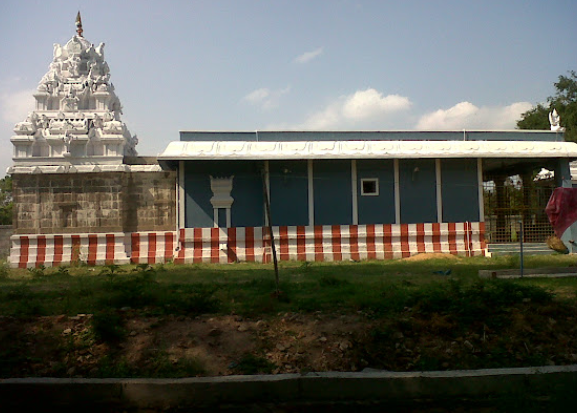The Venugopala Swamy Temple in Kaliyapettai has a rich historical background that dates back several centuries. It is believed to have been constructed by the local rulers to honour Lord Krishna in his divine form as Venugopala Swamy. Over the years, the temple has undergone several renovations and expansions, reflecting the architectural styles of different periods. The temple has served as a spiritual centre for the local community, hosting numerous religious and cultural events. Legends associated with the temple often highlight miraculous events and divine interventions, enhancing its sanctity. The temple's history is closely intertwined with the region's cultural and religious heritage, making it a revered pilgrimage site.

Sri Venugopalaswamy Temple
The Venugopala Swamy Temple is located in Kaliyapettai, Tamil Nadu. This temple, dedicated to Lord Krishna as Venugopala Swamy, features traditional South Indian architecture and vibrant sculptures. It is renowned for its serene ambiance and the grand celebration of Krishna Janmashtami. The temple is a tranquil spiritual retreat for devotees and visitors alike.
Timings
Morning: 6:00 AM - 12:00 PM & Evening: 4:00 PM - 8:00 PM
Entry Fee
No entry fee is charged
Do's and Don'ts
- Dress Modestly: Wear traditional clothing that covers shoulders and knees. For men, dhotis or trousers and shirts are appropriate; women should wear sarees or salwar kameez.
- Follow Temple Rules: Adhere to specific temple guidelines, such as designated areas for worship, photography restrictions, and visiting times.
- Remove Footwear: Always take off shoes and socks before entering the temple premises. There are usually designated areas for footwear.
- Offerings with Respect: Make offerings like flowers, fruits, and sweets with devotion and follow prescribed rituals.
- Maintain Silence: Keep noise levels low to ensure a peaceful environment for worship and meditation.
- Participate in Rituals: Join in rituals and ceremonies respectfully if invited, without disrupting the process.
- Respect the Deity: Approach the deity with reverence and do not touch sacred items without permission.
- Support Preservation Efforts: Contribute to or support preservation and charitable projects associated with the temple to maintain its cultural heritage.
- Avoid Photography: Do not take photographs inside the temple unless explicitly permitted, to maintain sanctity.
- No Loud Conversations: Avoid loud talking, laughing, or any disruptive behaviour that could disturb others.
- No Eating Inside: Do not eat or drink within the temple premises. Keep food and beverages outside the sacred area.
- Avoid Public Displays of Affection: Refrain from hugging, holding hands, or other public displays of affection inside the temple.
- Do Not Touch Sacred Objects: Avoid touching deities, idols, or sacred objects unless instructed by temple authorities.
- No Smoking or Drinking: Smoking and alcohol consumption are prohibited within the temple.
- Disregard Etiquette: Respect all customs and practices even if unfamiliar; disrespectful behaviour can be seen as offensive.
- Avoid Disruptive Behaviour: Do not engage in actions that could disrupt temple activities or disturb other visitors.
Dress Code
For Men: Wear traditional attire such as dhotis, or trousers with a shirt. Ensure clothing is modest and covers shoulders and knees.
For Women: Opt for sarees, salwar kameez, or other modest clothing that covers shoulders and knees. Avoid revealing or casual outfits.
How to reach
By Air: Chennai International Airport (approximately 75 kilometres from Kanchipuram). From the airport, you can hire a taxi or take a bus to Kanchipuram and then proceed to the temple.
By Train: This is the nearest major railway station. From the station, you can hire a taxi or auto-rickshaw to reach the temple. It is about 12 kilometres from the station.
By Bus: Several buses run to Kanchipuram from major cities. Once in Kanchipuram, you can take a local bus or hire a taxi to get to Kaliyapettai.
By Road: The temple is approximately 10-12 kilometres from Kanchipuram city centre. You can take a local taxi, auto-rickshaw, or drive yourself. Follow local road signs or GPS navigation for the best route.
Nearby Cities and Rivers
Rivers:
- Palar River: Located approximately 10-15 kilometres north of Kaliyapettai, the Palar River is a significant river in the region, flowing through Kanchipuram district.
Cities:
- Kanchipuram: The temple is situated in Kanchipuram district, known for its historical and cultural significance. Kanchipuram is renowned for its ancient temples and silk sarees.
- Chennai: Approximately 70 kilometres southeast of Kaliyapettai, Chennai is the capital city of Tamil Nadu and a major metropolitan hub with historical and economic importance.
- Tiruvannamalai: About 100 kilometres west of Kaliyapettai, Tiruvannamalai is a significant pilgrimage city known for the Arunachaleswarar Temple and its spiritual significance.
- Vellore: Located around 85 kilometres northwest of Kaliyapettai, Vellore is known for its historical fort and medical institutions.
- Pondicherry: Roughly 130 kilometres south of Kaliya Pettai, Pondicherry is a coastal city with a blend of French colonial architecture and Indian culture.